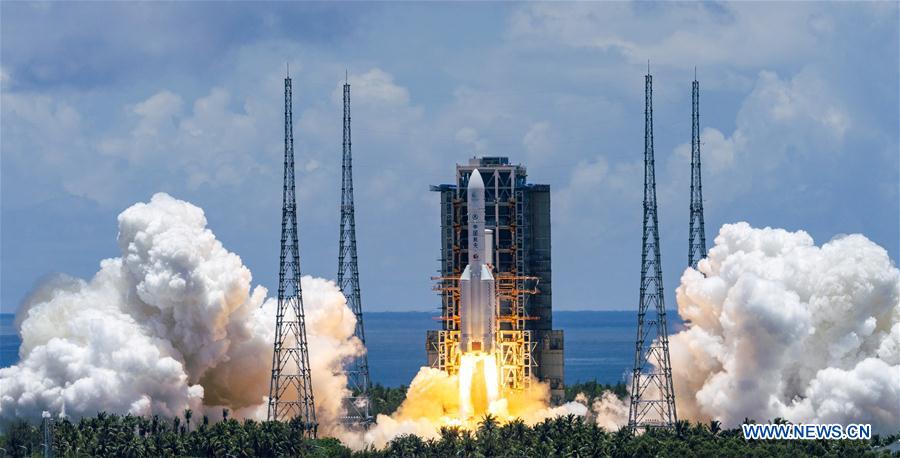China launched a Mars probe on Thursday (23 July 2020), designed to complete orbiting, landing and roving in one mission, taking the first step in its planetary exploration of the solar system.
A Long March-5 rocket, China’s largest launch vehicle, carrying the spacecraft with a mass of about 5 tonnes, soared into the sky from the Wenchang Spacecraft Launch Site on the coast of southern China’s island province of Hainan at 12:41 pm Beijing Time.
About 36 minutes later, the spacecraft, including an orbiter and a rover, was sent into the Earth-Mars transfer orbit, embarking on an almost seven-month journey to the red planet, according to the China National Space Administration (CNSA).
China’s first Mars mission is named Tianwen-1, which means Questions to Heaven and comes from a poem written by Qu Yuan (340-278 BC), one of the greatest poets of ancient China. The name is intended to signify China’s perseverance in pursuing truth and science and exploring nature and the universe, said the CNSA.
“The successful launch is only the first step of China’s Mars mission, and we hope each of the many key steps of the long journey is completed successfully,” said Geng Yan, an official at the Lunar Exploration and Space Program Center of the CNSA.
The key steps include slowing down when close to Mars, orbiting, separating the landing platform and the rover from the orbiter, landing softly and roving.
The craft is expected to enter the orbit of Mars around February 2021. Afterwards, it will spend two to three months surveying potential landing sites using a high-resolution camera to prepare for the landing in May.
The most challenging part of the mission will be the soft landing, an autonomous process of the probe lasting seven to eight minutes. The probe will use its aerodynamic shape, parachute and retrorocket to decelerate and buffer legs to touch down, said Geng.
After the landing, the rover will be released to conduct scientific exploration with an expected lifespan of at least 90 Martian days (around three Earth months), and the orbiter, with a design life of one Martian year (around 687 Earth days), will relay communications for the rover while conducting its own scientific detection.
Chinese space engineers and scientists have chosen a relatively flat region in the southern part of the Utopia Planitia, a large plain, as the potential landing zone.
“The reason we selected this place is that it has both the conditions for a safe landing and scientific research value. The place has not been investigated by other countries, so the scientific data can be shared with other countries to enrich the world’s understanding of Mars,” Geng said.
Earlier research showed the potential landing site might be the edge of an ancient ocean or lake in the early history of Mars. Chinese scientists are looking forward to finding more evidence of water-ice.
The scientific goals include mapping the morphology and geological structure, investigating surface soil characteristics and water-ice distribution, analyzing the surface material composition, measuring the ionosphere and the characteristics of the Martian climate and environment at the surface, and perceiving the physical fields and internal structure of Mars.
The orbiter is equipped with seven kinds of scientific instruments: two remote-sensing cameras, Mars-Orbiting Subsurface Exploration Radar, Mars Mineralogy Spectrometer, Mars Magnetometer, Mars Ion and Neutral Particle Analyzer, and Mars Energetic Particle Analyzer.
The six-wheel solar-powered rover, looking like a blue butterfly with a mass of 240 kg, carries the Terrain Camera, Multispectral Camera, Mars-Rover Subsurface Exploration Radar, Mars Surface Composition Detector, Mars Magnetic Field Detector and Mars Meteorology Monitor.
Challenge News Desk



